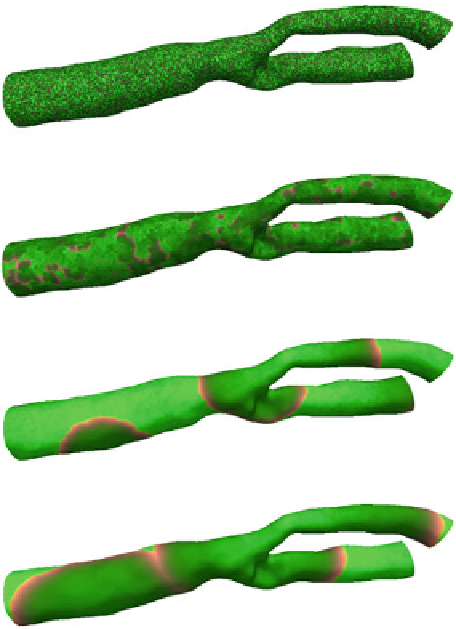Biomedical Engineering Reference
In-Depth Information
the surface discretization, or on the modelling strategy,
N
i
may represent the set of
connected surface points belonging to a patch centred on point (cell)
i
. The geometry
used for the simulation is a carotid artery, and has a total surface area of 8.26 cm
2
,
giving a mean cell surface area of
2
. The actual geometry of each SMC is
not modelled explicitly in the present formulation.
∼
143
µ
2.2.1
Ca
2
+
Coupling
All cells are dynamically identical except for the
A
parameter, which reflects influx
of
Ca
2
+
via NSCCs, and is randomly distributed around its mean value, given in
Table
1
. Parameter
A
was chosen for its strong modulatory effect on the oscillatory
frequency. A typical cellular matrix thus contains SMCs that are quiescent (either in
an under-stimulated or an over-stimulated state, in terms of
Ca
2
+
availability) and
cells that are oscillating spontaneously. Within this range, the oscillatory regime is
maintained at a physiological level.
Fig. 3
Computational
modelling results illustrating
the emergence of propagating
wave fronts. A gradual
transition of uncorrelated
oscillatory activity into
coherent patterns is observed
under conditions of increased
intercellular
Ca
2
+
coupling
(From
top
to
bottom g
Ca
=
0,
g
Ca
=
2,
g
Ca
=
10,
g
Ca
=
20). Colours are coded as:
red
=
cytosolic free
[
Ca
2
+
]
i
,
green
=[
Ca
2
+
]
SR
,
blue
=
membrane potential. A
magenta colour is seen where
red and blue strengths are
equal, and therefore indicative
of membrane depolarization
and high
Ca
2
+
influx

